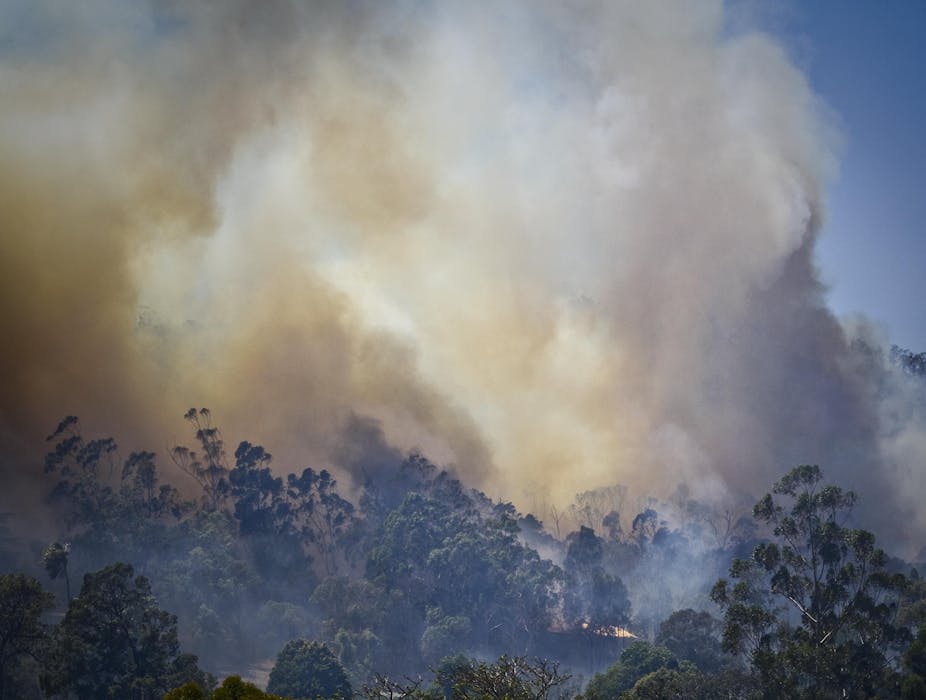Bushfires are, together with cyclones and flooding, among the most important natural hazards affecting Australian communities. They also make a significant contribution to Australia’s greenhouse gas emissions.
Australia has bushfires because of our inherently flammable vegetation types, the recurrence of severe droughts, and a high incidence of hot, dry weather conditions.
Management agencies cannot control climate and weather. Consequently, fire hazard reduction focuses primarily on reducing bushland fuel.
Starting fires to stop fires
In most of Australia’s fire-prone environments, “burning off” - more formally known as prescribed, or fuel-reduction burning - is the preferred method to reduce the density and spatial continuity of fuels.
By burning under controlled conditions, fuel loads can be reduced over large areas at relatively low cost. These burns generally target the understorey vegetation and surface litter, while aiming for minimum damage to overstorey trees.
Depending on the type of fuel, its accumulation rate and the intensity of the burn, fuel loads may take months to decades after a burn to recover to pre-treatment levels. If the fuel accumulation rate is high, burns need to happen frequently to keep fuel down to acceptable levels.
When fuel loads are relatively low, bushfires are generally less intense. This provides more opportunities to suppress the fires and reduce the severity of their ecological impacts.
However, when weather conditions are severe, differences in fire behaviour between treated and untreated areas can become negligible or irrelevant, as seen during the 2009 bushfires in Victoria.
Besides hazard reduction, prescribed burning is carried out to meet objectives such as biodiversity conservation, forest regeneration or management of water resources. These objectives require different frequencies, intensities, sizes, or seasons of fire to hazard reduction.
There are other ways of reducing bushland fuel. But methods such as mowing, thinning, or chaining tend to be used only in small areas (such as roadsides), where prescribed burning is deemed either too dangerous, expensive or undesirable (for example, because of smoke pollution).
Releasing emissions to prevent emissions
Burning biomass inevitably releases CO₂, CH₄, N₂O and other greenhouse gases (GHG) to the atmosphere. Emissions from vegetation fires account for about 3% of global GHG emissions.
Bushfires in Australia burn over 500,000 km² annually, mainly in the northern half of the country. They account for about 6-8% of global fire emissions and contribute significantly (about 3%) to the nation’s net GHG emissions.
So can prescribed burning help reduce carbon emissions from fire-prone environments?

Recent studies from North America and Europe claim that prescribed burning could produce major reductions in emissions from forest fires.
These claims need to be evaluated for Australia. Our initial assessment suggests there is good potential for mitigating carbon emissions with prescribed burning in tropical savannas, but probably little or no such potential in temperate forests of southern Australia. This is because there are fundamental differences in fuel dynamics and fire behaviour between the two environments.
Prescribed burning will only reduce carbon emissions from a landscape if it reduces the extent of unplanned fire and if it burns less fuel per hectare than an unplanned fire would.
Good potential for the savanna, uncertainties for the forest
Analysis of historical fire records shows that prescribed burning does much more to reduce unplanned fires in tropical savannas than it does in temperate forests.
In the tropical savannas, every hectare of prescribed burning yields about one hectare reduction in the extent of wildfires, on average.
Planned savanna fires also burn less fuel than wildfires would in the same area. They are usually conducted early in the dry season, when fuels are moist, while unplanned fires are more frequent later in the dry season when fuels have thoroughly dried-out.
The feasibility of mitigating carbon emissions from flammable tropical savannas through prescribed burning is already being demonstrated in the West Arnhem Land Fire Abatement Project.
In the forested regions of southern Australia prescribed burning is less effective in mitigating unplanned fire. To get a hectare less of wildfire you have to burn three to four hectares with prescribed fire.
To reduce emissions under these circumstances, fuel consumption rates of planned fires have to be a very small fraction of those of unplanned fires.
So far, we can’t tell whether that’s the case, though future research should produce the numbers to make that call.

